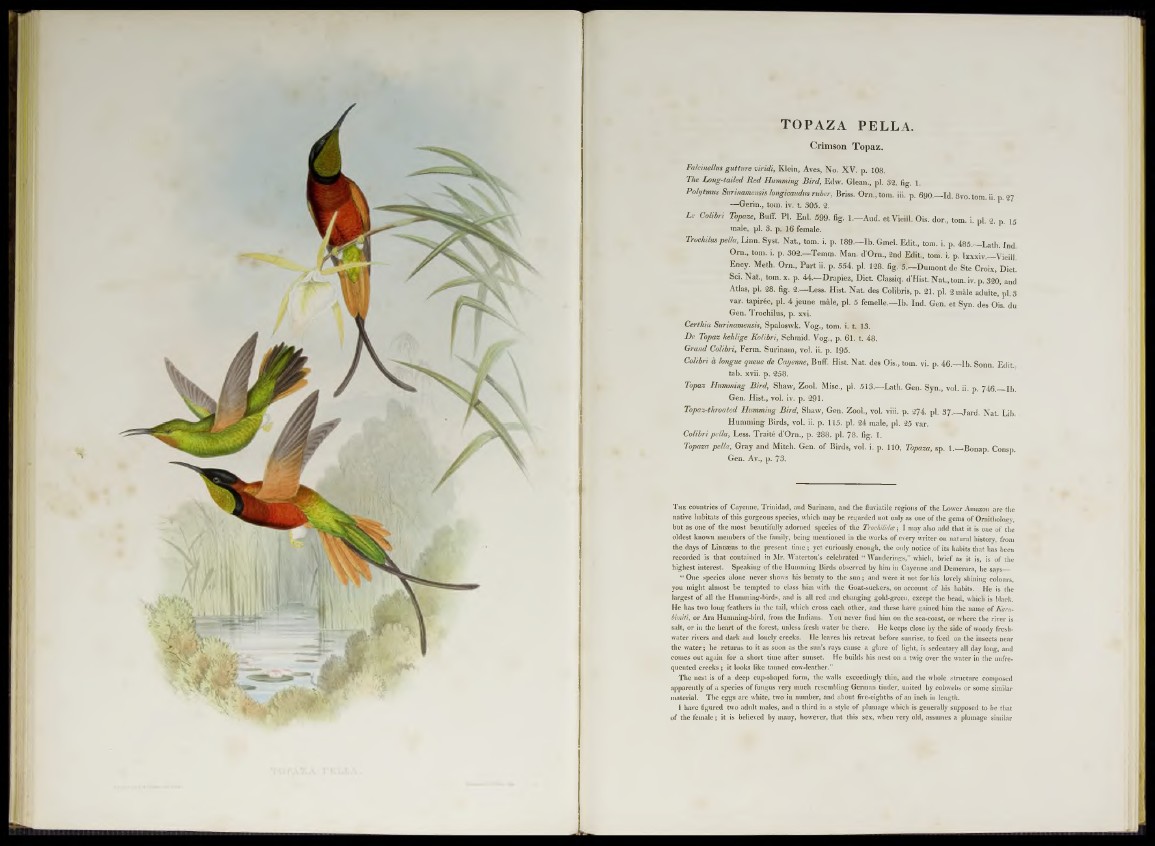
TOPAZA PELLA.
Crimson Topaz.
Falcinellm gutture viridi, Klein, Aves, No. XV. p. 108.
The Long-tailed R ed Humming Rird, Edw. Glean., pl. 32. fig. 1.
Polytmus Surinamensis longicaudm ruber, Briss. Orn.,tom. iii. p. 690.—Id. 8vo. tom. ii. p. 27
—Gerin., tom. iv. t. 305. 2.
Le Colibri Topaxe, Bnff. PI. Enl. 599. fig. 1.—And. etVieill. O Is. dor., tom. i. pl. 2. p . 15
male, pl. 3. p. 16 female.
Trochihts pella, Linn. Syst. Nat., tom'. i. p. 189.—Ib. Gmel. Edit., tom. i. p. 485.—Lath. Ind
Orn., tom. i. p. 302.—Temm. Man. d’Orn., 2nd Edit., tom. i. p. lxxxiv.—VieilL
Ènèy. Meth. Orn., P a rt ii. p. 554. pl. 128. figi=£—Dnmont de Ste Croix, Dict!
Sci. N a t, tom. x. p. 44.—Drapièz, D ic t Classiq. d’Hist. N a t.tom .iv .p . 320, and
Atlas, pl. 28. fig. 2 .—Less. Hist, Nat. des Colibris.p. 21, pl, 2 m&le aduite, pl.S
var. tapirée, pl. 4 jeune m f e pl. 5 femelle.—Ib. Ind. Gen. et Syn. des Ois. du
Gen. Trochilus, p. xvi.
Certhia Surinamensis, Spaloswk. Vog., tom. i. t. 13.
De Topaz kehlige Kolibri, Schmid. Vog., p. 61. t. 48.
Grand Colibri, Ferm. Surinam, vol. ii. p. 195.
Colibri a longue queue de Cayenne, Buff. Hist. Nat. des Ois., tom. vi. p. 46. Ib. Sonn. Edit.
tab. xvii. p. 258.
Topaz Humming B ird , Shaw, Zool. Misc., pl. 513.—Lath. Gen. Syn., vol. ii. p. 746. Ib.
Gen. Hist., vol. iv. p. 291.
Topaz-throated Humming Bird, Shaw, Gen. Zool., vol. viii. p. 274. pl. 37. Jard. Nat. Lib
Humming Birds, vol. ii. p. 115. pl. 24 male, pl. 25 var.
Colibri pella, Less. Traité d’Orn., p. 288. pl. 78. fig. 1.
Topaza pella, Gray and Mitch. Gen. of Birds, vol. i. p. 110, Topaza, sp. I. Bonap. Consp.
Gen. Av., p. 73.
T he countries of Cayenne, Trinidad, and Surinam, and the fluviatile regions of the Lower Amazon are the
native habitats of this gorgeous species, which may be regarded not only as one of the gems of Ornithology,
but as one of the most beautifully adorned species of the Trochilidce; I may also add that it is one óf the
oldest known members of the family, being mentioned in the works of every writer on natural history from
the days of Linnseus to the present time ; yet curiously enough, the only notice of its habits that has been
recorded is that contained in Mr. Waterton’s celebrated “ Wanderings,” which, brief as it is, is of the
highest interest. Speaking of the Humming Birds observed by him in Cayenne and Demerara, he says__
“ One species alone never shows his beauty to the sun ; and were it not for his lovely shining colours,
you might almost be tempted to class him with the Goat-suckers, on account of his habits. He is the
largest of all the Humming-birds, and is all red and changing gold-green, except the head, whicü is black.
He has two long feathers in the tail, which cross each other, and these have gained him the name of Kara-
bimiti, or Ara Humming-bird, from the Indians. You never find him on the sea-coast, or where the river is .
salt, or in the heart of the forest, unless fresh water be there. He keeps close by the side of woody fresh-
water rivers and dark and lonely creeks. He leaves his retreat before sunrise, to feed on the insects near
the water; he returns to it as soon as the sun’s rays cause a glare of light, is sedentary all day long, and
comes out again for a short time after sunset. He builds his nest on a twig over the water in the unfre-
quented creeks; it looks like tanned cow-leather.”
The nest is of a deep cup-shaped form, the walls exceedingly thin, and the whole structure composed
apparently of a species of fungus very much resembling German tinder, uuited by cobwebs or some similar
material. The eggs are white, two in number, and about five-eighths of an inch in length.
I have figured two adult males, and a third in a style of plumage which is generally supposed to be that
of the female; it is believed by many, however, that this sex, when very old, assumes a plumage similar